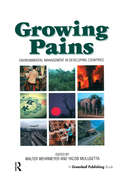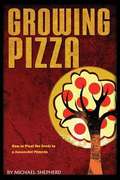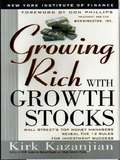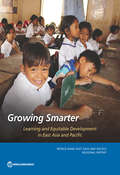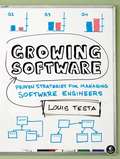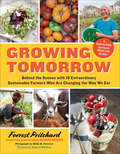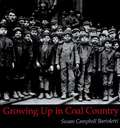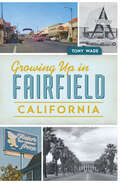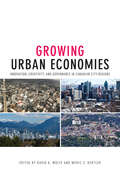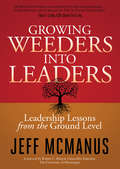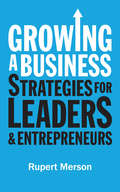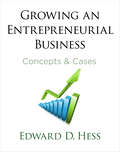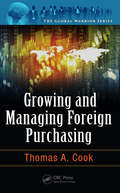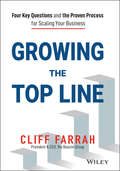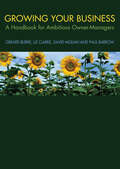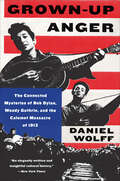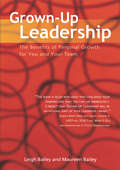- Table View
- List View
Growing Pains: Environmental Management in Developing Countries
by Walter Wehrmeyer Yacob MulugettaEnvironmental management is a global phenomenon, embracing all businesses in all countries, whether or not there already exists an organised response to managing environmental impacts. Today, there are gross inequalities between the world's richest and poorest nations in terms of income distribution, consumption patterns, access to resources and environmental impact. Yet both the developed north and the developing south are committed, at least in words, to achieving sustainable development. Public awareness of environmental issues in the North has been rising in recent years and further degradation is now largely minimized through more stringent regulatory regimes, voluntary agreements and growing consumer and stakeholder pressure on corporations. Still, the north is continuing to lead an environmentally unsustainable lifestyle as environmental improvements are nullified by overall increases in consumption levels. In the south, a billion people still do not have access to the most basic needs. Poor countries need to accelerate their consumption growth if they are to ensure that the lives of their people are enriched. However, with rapid economic growth and corresponding increases in consumption now under way, their environmental impact is soon to become substantially greater. In a world that strives towards stemming global crises such as climate change, the path already taken by the rich and high-growth economies over the past century cannot be repeated by the south if the desired objective is to create a future that is truly sustainable. Growing Pains examines environmental management in the south from a number of perspectives. It is designed to stimulate the discussion about the role that corporations and national and international organizations play in sustainable development. It does not offer panaceas, as each country has its own problems and opportunities; and, after almost 50 years of failed panacea-oriented economic development policy transfer from the north to the south, it is time to abandon hope for universal solutions and instead look to individual approaches that work. The book is divided into five themes: globalization; the role of business; a focus on national strategies; trade and the environment; and the organizational and structural challenges of sustainable development. With contributions from an outstanding collection of authors in both the developed and developing worlds including UNIDO; the Thailand Environment Institute, Arthur D. Little, Inc., Shell Peru; IUCN, the Russian Academy of Sciences and IIED, this important and unique new book presents a body of work that will provide essential reading for businesses working in developing countries, environmental and developmental NGOs and researchers engaged in the debate and sharing of best practice in this increasingly critical subject area.
Growing Pizza: How to Plant The Seeds to a Successful Pizzeria
by Michael ShepherdWhat if you could operate your restaurant on a level that your competitors couldn't? What if you could build a foundation so solid that you never had to even think about your competition? How about planting the marketing seeds that will allow you to operate with a near zero advertising budget? And what if you never had to use traditional mass advertising ever again? Growing Pizza will take you inside the mind of pizza maker and marketing expert Michael Shepherd, who took a failing 'Mom & Pop' pizza shop and built it into a multi-million dollar restaurant business. Michael's outside the box marketing strategies, foundation laying techniques, and 'celebrity' building methods have driven his pizzeria success far beyond anyone's expectations.
Growing Public
by Peter H. LindertGrowing Public examines the question of whether social policies that redistribute income impose constraints on economic growth. Taxes and transfers have been debated for centuries, but only now can we get a clear view of the whole evolution of social spending. What kept prospering nations from using taxes for social programs until the end of the nineteenth century? Why did taxes and spending then grow so much, and what are the prospects for social spending in this century? Why did North America become a leader in public education in some ways and not others? Lindert finds answers in the economic history and logic of political voice, population aging, and income growth. Contrary to traditional beliefs, the net national costs of government social programs are virtually zero. This book not only shows that no Darwinian mechanism has punished the welfare states, but uses history to explain why this surprising result makes sense. Contrary to the intuition of many economists and the ideology of many politicians, social spending has contributed to, rather than inhibited, economic growth.
Growing Rich with Growth Stocks
by Kirk KazanjianThere have been many books written about financial wizards, but this one is about five Wall Street sages. Read and learn how to quickly apply their 12 logical rules to investing in growth stocks. This is a timely book for all times! Ralph J. Acampora, CMT Managing Director, Prudential Securities, Inc. When Donald Yacktman, Shelby Davis, Elizabeth Bramwell, L. Roy Papp, and Robert Stovall talk, investors the world over listen. These experts collectively not only manage billions of dollars, but have also posted some of the best performance results of money managers on Wall Street today. Now noted investment analyst and author Kirk Kazanjian takes readers behind-the-scenes with these luminaries and reveals their most successful investment secrets. As an added bonus, each 'guru' offers his or her top 10 growth stock picks for the next millennium. Complete with candid, personal biographies that both paint an informative portrait of these money managers and offer an insight into what makes them tick, Kazanjian provides 12 easy-to-follow rules that get right to the heart of knowing how to spot tomorrow's most promising investment's today:
Growing Smarter: Learning and Equitable Development in East Asia and Pacific (World Bank East Asia and Pacific Regional Report)
by World BankOne-quarter of the world’s school-age children live in East Asia and Pacific. During the past 50 years, some economies in the region have successfully transformed themselves by investing in the continuous upgrading of the knowledge, skills, and abilities of their workforce. Through policy foresight, they have produced graduates with new levels of knowledge and skills almost as fast as industries have increased their demand for skilled workers. Yet the success of these high-performing systems has not been replicated throughout the region. Tens of millions of students are in school but not learning, and as many as 60 percent of students remain in school systems that are struggling to escape from the global learning crisis or in systems where performance is likely poor. Many students in these systems fail to reach basic levels of proficiency in key subjects and are greatly disadvantaged because of it. Growing Smarter: Learning and Equitable Development in East Asia and Pacific focuses on the experiences of economies in the region that have been able to expand schooling and learning and showcases those that have managed to pursue successful education reforms at scale. By examining these experiences, the report provides both diagnoses and detailed recommendations for improvement not only for education systems within East Asia and Pacific but also for countries across the globe. In East Asia and Pacific, the impressive record of success in education in some low- and middle-income countries is proof of concept that schooling in resource-constrained contexts can lead to learning for all. This report identifies the policies and practices necessary to ensure that students learn and suggests how countries can improve learning outcomes.
Growing Software: Proven Strategies for Managing Software Engineers
by Louis Testa<P>As the technology leader at a small software company, you need to focus on people, products, processes, and technology as you bring your software to market, while doing your best to put out fires and minimize headaches. <P>Growing Software is your guide to juggling the day-to-day challenges of running a software company while managing those long-term problems and making sure that your business continues to grow. With practical, hands-on advice, Growing Software will teach you how to build and lead an effective team, define and sell your products, work with everyone from customers to CEOs, and ensure high-quality results.Instead of learning by trial and error, you'll benefit from author Louis Testa's 20+ years of management experience. Testa combines big-picture advice, specific solutions, and real-life anecdotes to teach you how to: <br>–Work effectively with your CEO and executive team <br>–Improve development team efficiency and enthusiasm <br>–Evaluate your software methodology to improve effectiveness and safeguard against failure <br>–Use product prototypes to bridge the gap between marketing and engineering <br>–Defuse technology time bombs <P>Whether you're new to managing software or newly lost, Growing Software will help you and your growing company thrive.
Growing Tomorrow: A Farm-to-Table Journey in Photos and Recipes: Behind the Scenes with 18 Extraordinary Sustainable Farmers Who Are Changing the Way We Eat
by Deborah Madison Forrest Pritchard Molly M. PetersonMeet the local farmers who feed America—in stories, photos, and 50 recipes! When Forrest Pritchard went looking for the unsung heroes of local, sustainable food, he found them at 18 exceptional farms all over the country. In Detroit, Aba Ifeoma of D-Town Farm dreams of replenishing the local “food desert” with organic produce. On Cape Cod, Nick Muto stays afloat and eco-friendly by fishing with the seasons. And in Washington State, fourth-generation farmer Robert Hayton confides, “This farm has been rescued by big harvests. . . . For every one great season, though, you’ve got ten years of tough.” With more than 50 mouthwatering recipes and over 250 photographs, this unique cookbook captures the struggles and triumphs of the visionary farmers who are Growing Tomorrow.
Growing Up in China: The Financing of BabyCare Ltd.
by Mihir A. Desai Mark F. VeblenThe CFO of this infant nutritional products company must choose among competing financing offers. The interplay of Chinese legal and customs restrictions and venture capitalists' bargaining techniques challenge the CFO to navigate a tricky negotiation and to devise a unique business model given these constraints. The case provides a valuation exercise and highlights some of the difficult questions a discerning venture capitalist might ask, requiring the CFO to justify his overall business model and working capital needs. To obtain executable spreadsheets (courseware), please contact our customer service department at custserv@hbsp.harvard.edu.
Growing Up in Coal Country
by Susan Campbell BartolettiThrough interviews, newspaper accounts, and other original sources, Bartoletti pieced together a picture of life in the Pennsylvania coal mines at the turn of the century.
Growing Up in Fairfield, California
by Tony WadeA magic nostalgia ride awaits.Life in Fairfield in the decades after World War II was an unparalleled experience. From cruising down Texas Street on weekends to catching a carnival in the Wonder World parking lot, fond memories of long-lost times haven't been forgotten. People flocked to vintage eateries like Joe's Buffet and Smorga Bob's, and played on the rocket ship slide at Allan Witt Park. Roller Rinks like the M&M Skateway hosted not just skaters, but dances featuring Fats Domino and Roy Orbison. Commuters hopped aboard the FART bus to save on gas, and frequenting Dave's Giant Hamburgers was a rite of passage.Longtime Daily Republic journalist and accidental historian Tony Wade takes a deep dive into the Fairfield of yesteryear.
Growing Urban Economies: Innovation, Creativity, and Governance in Canadian City-Regions
by David A. Wolfe Meric S. GertlerEven in a globalizing, knowledge-based economy, cities remain engines of growth, innovation, and diversity. Increasingly, they are also active participants in the creation of the social and political conditions necessary to create a thriving community. The Innovation, Creativity, and Governance in Canadian City-Regions series is a focused analysis of how developments at the local and regional level affect these three key determinants of future prosperity. Growing Urban Economies summarizes its conclusions in a single volume that presents an overview of the evidence and its implications.A rich and nuanced analysis of the interplay of social, political, and economic factors in thirteen Canadian city-regions, large and small, this collection integrates research focusing on innovation, creativity and talent-retention, and governance in order to understand the distinctive experience of each region. A valuable cross-section of city-region development in a variety of circumstances, Growing Urban Economies offers important insights into the way in which local conditions affect urban economies around the world.
Growing Weeders Into Leaders: Leadership Lessons from the Ground Level
by Jeff McManusOne of America&’s most accomplished landscaping professionals reveals his methods for cultivating greatness. Nowadays, greatness tends to be measured by shortest or longest times, highest heights, medals won, honors given. But as Aristotle taught us, greatness is what we can do every day, without recognition or reward, for the satisfaction that comes from meeting the challenge, creating a team, and overcoming the odds. Under Jeff McManus&’s leadership as Director of Landscape Services, the Ole Miss campus has won professional awards—and been cited by Newsweek and Princeton Review as America&’s &“most beautiful campus.&” In Growing Weeders into Leaders, he relates the principles behind his team&’s success. It is an entertaining and thoughtful look into the hearts and the workday lives of ordinary people who tapped into their inner greatness in pursuit of a vision. Creating one of America&’s most beautiful college campuses at the University of Mississippi did not happen overnight and, inside these pages, McManus describes the joys, the defeats, the brilliant problem-solving and the best laid plans that are proven worthless . . . until the bigger picture appears. This is the bigger picture as viewed from the ground level—taking you through the practical applications of empowering people to experience not only what it means to grow outstanding landscapes, but also to grow greatness in themselves and encourage it in others. &“A straightforward approach to problem-solving and methods to grow individuals into a team.&” —Susanne Woodell, CGM Historic Gardens Manager, Biltmore
Growing Your Own: How to Lead So People Develop
by Lisa Laskow Lahey Robert KeganChange dominates our work lives, our home lives, our politics, economics, and culture. Global thought leaders and practitioners alike constantly talk of change, but it's no surprise that less attention is paid to the feelings, anxieties, and motivations that spur passionate commitment NOT to change. This immunity to change is at the heart of individual and collective change prevention. Leaders and organizations that can master this force will dominate in the new century. They will set the standard in terms of accomplishing their own goals. They will be most admired by their competitors. They will have the greatest loyalty and commitment of their internal constituents. This chapter examines how your organization can become a home for the continuing transformation of talent and help more people unlock their full potential. This chapter is excerpted from "Immunity to Change: How to Overcome It and Unlock the Potential In Yourself and Your Organization."
Growing a Business: Strategies for Leaders & Entrepreneurs (Economist Books)
by Rupert MersonGrowth is a clear goal for ambitious entrepreneurs and leaders. It's often a short hand for business - and wider economic - success. But it's not without its pitfalls and challenges, and planning for, and managing, a growing business needs careful thought. Take, for example, the start-up facing for the first time the need to balance flexibility with more structure. Or a larger business tackling a range of divisions evolving at different speeds. Or an inspirational owner-founder confronting the need to step back and let other take the business forward. These are the kinds of challenges that Growing a Business tackles head-on. Drawing on a wide range of models and research and using case studies from across the business world, it offers practical advice and guidance on a whole range of topics, including: the different types and stages of growth; predicting the problems presented by growth; identifying growth triggers and barriers; the implications of growth: financially, culturally and for the people involved in the business. Growing a Business is required reading for owners and managers looking to understand a foster growth in their businesses.
Growing a Cluster: The Singapore Biomedical Sciences Initiative
by Michael E. Porter Christian H.M. KetelsCase
Growing an Entrepreneurial Business: Concepts & Cases
by Edward HessGrowing an Entrepreneurial Business: Concepts and Cases is a textbook designed for courses that focus on managing small to medium sized enterprises. It focuses on the major management challenges that successful start-ups encounter when leaders decide to grow and scale their businesses. The book is divided into two parts—text and cases—to provide professors with maximum flexibility in organizing their courses. The thirty-five cases can be used in conjunction with the text, or independently. Twelve cases are written as narratives with multiple teaching points, but without a focus on a particular business decision; the remaining twenty-three cases were written around specific conundrums related to strategy, operations, finance, marketing, leadership, culture, human resources, organizational design, business model, and growth. Discussion questions are provided for each case. The text portion of the book discusses key issues derived from the author's research and consulting, and is meant to complement the case method of teaching, raising issues for conversation. In addition to the real-world knowledge that students will derive from the cases, readers will take away research-based templates and models that they can use in developing or consulting with small businesses.
Growing and Managing A Small Business: An Entrepreneurial Perspective
by Kathleen R. AllenGrowing and Managing a Small Business provides students with a comprehensive introduction to business ownership and management from the start-up phase through growth and harvest. Decidedly entrepreneurial in focus, this book departs from the traditional small business management text by incorporating themes and principles appropriate to managing small companies in a dynamic, global environment. In addition to up-to-date coverage of risk management and strategies for "harvesting the business," the Second Edition introduces several new chapters that examine topics such as ethics and social responsibility, family businesses, and technology. New boxed features illustrate the author's real-world approach through case studies and profiles of small businesses and entrepreneurs.
Growing and Managing Foreign Purchasing (The Global Warrior Series #4)
by Thomas A. CookThis book compares the basic skillset of domestic purchasing to that of global purchasing. It provides a very detailed blueprint and best practices guide for avoiding costly mistakes and improving purchasing effectiveness. It also details supply chain globalization impacts on freight, logistics, customs issues, managing foreign suppliers, risk mitigation, and profit potential improvement. It differentiates itself from other books as being more comprehensive, detailed, and broad reaching into every aspect of purchasing on an international scale.
Growing from the Core: Developing and Refining Your Growth Strategy
by James Allen Chris ZookInternational bestseller Profit from the Core was originally published in 2001 and helped many companies find their way back to profitable growth after the Internet bubble burst. Now, the fully updated edition points the way forward in today's economy with new examples and data that demonstrate how companies have met the challenges and opportunities of turbulent times by returning to their core businesses. In today's unstable business environment, change--in company strategies, structures, and people--is crucial to achieving sustained profitable growth. To master change, managers must pursue it, not resist it. This chapter summarizes the opportunities and risks of seeking to grow the core in a turbulent business environment. It concludes with ten key questions managers should ask about their companies as they embark on growth initiatives. This chapter was originally published as Chapter 5 of Profit from the Core (Updated Edition): A Return to Growth in Turbulent Times.
Growing the Top Line: Four Key Questions and the Proven Process for Scaling Your Business
by Cliff FarrahPioneering growth strategist Cliff Farrah reveals how to grow revenue like a Fortune 500 giant Growing the Top Line: Four Key Questions and the Proven Process to Scaling Your Business delivers the step-by-step approach to topline growth used by some of the word’s most successful companies. In this book, leading growth strategy consultant and author, Cliff Farrah, reveals the copyrighted growth strategy that he has developed over the last twenty years through 1,400 successful client engagements and input from leaders at Fortune 500 organizations. Featuring interviews from current and prior leaders at major corporations like Intel, Nike, Chase, Oracle, Raytheon, and the WHO, Growing the Top Line demonstrates that regular business growth isn’t a mystery to be "hacked." Instead, Farrah distills revenue growth into a simple methodology that readers can use to successfully plan growth at their own companies. Readers will discover: The four questions each business leader must ask him or herself when formulating a growth strategy The sixteen different pathways to growth that those four questions unlock, and how to follow them Interviews with key leaders and executives who bring the author's framework to life Perfect for executives, managers, and entrepreneurs tasked with growing revenue, Growing the Top Line also belongs on the bookshelves of business enthusiasts and employees who hope to make a quantifiable impact in their work.
Growing your Business: A Handbook for Ambitious Owner-Managers
by Liz Clarke Paul Barrow Gerard Burke David MolianGrowing Your Business helps owner/managers develop growth strategies for their businesses by providing frameworks, ideas, inspiration and hands-on assignments. Its contents are a distillation of the authors’ knowledge and experience, which has successfully helped hundreds of owner/managers to grow and develop their businesses and themselves over the last twenty years. Filled with case studies and examples of businesses involved with the world-renowned Business Growth and Development Programme (BGP) at the Cranfield School of Management, this book covers all industry sectors and includes high profile names such as Karan Bilimoria of Cobra Beer, Angus Thirlwell of Hotel Chocolat and Lara Morgan of Pacific Direct. As well as being an ideal text for courses and modules in small business development and business growth at undergraduate and MBA levels, this book also stands on its own as an invaluable 'workbook' that enables any owner manager to develop their own growth strategy and take their business to the next level.
Growing your Business: A Handbook for Ambitious Owner-Managers
by Liz Clarke Paul Barrow Gerard Burke David MolianGrowing Your Business helps owner/managers develop growth strategies for their businesses by providing frameworks, ideas, inspiration and hands-on assignments. Its contents are a distillation of the authors knowledge and experience, which has successfully helped hundreds of owner/managers to grow and develop their businesses and themselves ov
Grown-Up Anger: The Connected Mysteries of Bob Dylan, Woody Guthrie, and the Calumet Massacre of 1913
by Daniel WolffA brilliantly intertwined account of two revolutionary musicians, a miners’ strike, and a deadly tragedy: “Reads like a historical detective story.” —The New York Times Book ReviewAt thirteen, when he first heard Bob Dylan’s “Like a Rolling Stone,” Daniel Wolff recognized the sound of anger. When he later discovered “Song for Woody,” Dylan’s tribute to folk musician Woody Guthrie, Wolff fixed on it as a clue to a distinctive mix of rage and compassion. That clue led back to Guthrie’s “1913 Massacre”—a memorial song about the horrific conclusion to a union Christmas party in Calumet, Michigan.Following the trail from Dylan to Guthrie to a tragedy that claimed seventy-four lives, Wolff found himself tracing a century-long line of anger. From America’s early industrialized days up to the present, the battle over economic justice keeps resurfacing: on a freight car in California, on a joyride through New Orleans, in a snowy field in Michigan. At the stunning conclusion—as the mysteries of Dylan, Guthrie, and the 1913 tragedy connect—the reader discovers a larger story, purposely distorted and buried in time.A tour de force of storytelling years in the making that chronicles the struggles between the haves and have-nots, Grown-Up Anger is both a dual biography of two legendary songwriters and a murder mystery. It also serves as a history of labor relations and socialism, big business and greed in twentieth-century America—all woven together in one epic saga.“A fascinating and relevant whirlwind examination of music, economic injustice, and two American icons.” —Booklist (starred review)“A masterful tale of music, social, and economic history . . . A dazzling, richly researched story impeccably told.” —Kirkus Reviews (starred review)
Grown-Up Leadership: The Benefits of Personal Growth for You and Your Team
by Leigh Bailey Maureen Bailey<p>As leader, are you an Intimidator (seeking control) or Accommodator (seeking acceptance)? Identify and accept your type, then build complementary skills for leadership excellence.</p>
